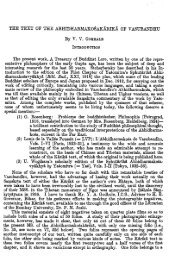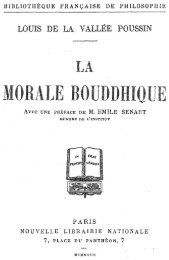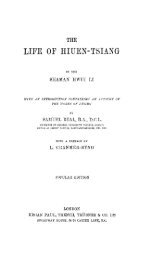La Vallée Poussin Musīla and Nārada. The Path - Gampo Abbey
La Vallée Poussin Musīla and Nārada. The Path - Gampo Abbey
La Vallée Poussin Musīla and Nārada. The Path - Gampo Abbey
You also want an ePaper? Increase the reach of your titles
YUMPU automatically turns print PDFs into web optimized ePapers that Google loves.
Musıla <strong>and</strong> N›rada. <strong>The</strong> <strong>Path</strong> of Nirv›˚a: by Louis de <strong>La</strong> <strong>Vallée</strong> <strong>Poussin</strong><br />
Those who die with passions connected with the desire realm are reborn in the desire realm<br />
Those who have been liberated from these passions <strong>and</strong> who have risen to the first meditation<br />
are reborn in the heaven of the first meditation, because they are tied by the passions of this<br />
meditation, because they love the meditative joy particular to this meditation; <strong>and</strong> so on.<br />
<strong>The</strong> passions connected with each of these nine stages are of nine categories, strong-strong,<br />
strong-medium, strong-weak, medium-strong…<br />
<strong>The</strong> passions are expelled by the path of cultivation (bh›van›).<br />
One distinguishes:<br />
8<br />
1. the ‘supramundane’ (lokottara) cultivation (F 195), reserved for the practitioners who<br />
have ‘viewed the truths’ (d¸˝˛asatya),<br />
2. ‘mundane’ (laukika) cultivation (F 195-198) which non-Buddhists can <strong>and</strong> do practice.<br />
<strong>The</strong> gods who inhabit the eight higher stages of the world are, with the exception<br />
notably of the ‘Pure Abodes’ (Ÿuddh›v›sika), non-Buddhist practitioners who have practiced the<br />
mundane cultivation.<br />
AAB.1. THE SUPRAMUNDANE CULTIVATION; F 195<br />
<strong>The</strong> supramundane (lokottara) cultivation (bh›van›) is simply the ‘repeated vision’ of the truths:<br />
bh›van› means more or less ‘repetition’.<br />
A first vision of the truths, the general vision of the universe according to the truths, has<br />
uprooted the ‘errors’. <strong>The</strong> practitioners now consider the factors of the desire realm (k›madh›tu),<br />
of the first meditation (dhy›na)… of the fourth formless equipoise as being suffering,<br />
impermanent, empty, nonself – two times nine visions per stage 10 – <strong>and</strong> free themselves from<br />
all desire towards these things.<br />
In order to ‘envision’ or ‘repeatedly envision’ the truths, a certain state of concentration (sam›dhi)<br />
is required. But in order to feel disgust with the successive levels of existence <strong>and</strong> to free<br />
themselves from the ‘passions’ corresponding to them, the practitioners do not necessarily have<br />
to enter into the concentrations that correspond to these levels. <strong>The</strong>y can restrict themselves to<br />
considering the aggregates (sk<strong>and</strong>ha; form, etc.) of these levels, <strong>and</strong> to recognize their nature as<br />
suffering, impermanent, etc.<br />
First, the practitioners free themselves from the first six categories of passions of the desire realm<br />
<strong>and</strong> become once-returners (sak¸d›gamin), noble persons who will be reborn not more than once<br />
in the desire realm; next, [they free themselves] from the last three [categories of the desire<br />
10 KoŸa, vi, 190, nine ‘paths of immediate succession’ (›nantaryam›rga) <strong>and</strong> nine ‘paths of liberation’<br />
(vimuktim›rga) per stage, see above, F 194.






